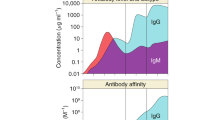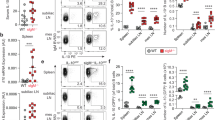Abstract
B1 cells are an important cell population for the production of natural antibodies and for antibacterial immunoglobulin responses. Here we identified the mouse protein Siglec-G as a B1 cell inhibitory receptor. Siglec-G was expressed in a B cell–restricted way, with large amounts present in B1 cells. When overexpressed, Siglec-G inhibited B cell receptor–mediated calcium signaling. Siglec-G-deficient mice had massive expansion of the B1a cell population, which began early in development and was B cell intrinsic. Siglec-G-deficient mice had higher titers of natural IgM antibodies but not a higher penetrance of IgG autoantibodies. Siglec-G-deficient B1 cells showed a strongly enhanced calcium signaling. Our results demonstrate that Siglec-G-dependent negative regulation exists in B1 cells, which may explain the naturally muted signaling response of B1 cells.
This is a preview of subscription content, access via your institution
Access options
Subscribe to this journal
Receive 12 print issues and online access
$209.00 per year
only $17.42 per issue
Buy this article
- Purchase on Springer Link
- Instant access to full article PDF
Prices may be subject to local taxes which are calculated during checkout






Similar content being viewed by others
Accession codes
References
Berland, R. & Wortis, H.H. Origins and functions of B-1 cells with notes on the role of CD5. Annu. Rev. Immunol. 20, 253–300 (2002).
Martin, F. & Kearney, J.F. Marginal-zone B cells. Nat. Rev. Immunol. 2, 323–335 (2002).
Haas, K.M., Poe, J.C., Steeber, D.A. & Tedder, T.F. B-1a and B-1b cells exhibit distinct developmental requirements and have unique functional roles in innate and adaptive immunity to S. pneumoniae. Immunity 23, 7–18 (2005).
Alugupalli, K.R. et al. B1b lymphocytes confer T cell-independent long-lasting immunity. Immunity 21, 379–390 (2004).
Ha, S.A. et al. Regulation of B1 cell migration by signals through Toll-like receptors. J. Exp. Med. 203, 2541–2550 (2006).
Herzenberg, L.A. B-1 cells: the lineage question revisited. Immunol. Rev. 175, 9–22 (2000).
Montecino-Rodriguez, E., Leathers, H. & Dorshkind, K. Identification of a B-1 B cell-specified progenitor. Nat. Immunol. 7, 293–301 (2006).
Cong, Y.Z., Rabin, E. & Wortis, H.H. Treatment of murine CD5- B cells with anti-Ig, but not LPS, induces surface CD5: two B-cell activation pathways. Int. Immunol. 3, 467–476 (1991).
Lam, K.P. & Rajewsky, K. B cell antigen receptor specificity and surface density together determine B-1 versus B-2 cell development. J. Exp. Med. 190, 471–477 (1999).
Sidman, C.L., Shultz, L.D., Hardy, R.R., Hayakawa, K. & Herzenberg, L.A. Production of immunoglobulin isotypes by Ly-1+ B cells in viable motheaten and normal mice. Science 232, 1423–1425 (1986).
Pan, C., Baumgarth, N. & Parnes, J.R. CD72-deficient mice reveal nonredundant roles of CD72 in B cell development and activation. Immunity 11, 495–506 (1999).
Otipoby, K.L. et al. CD22 regulates thymus-independent responses and the lifespan of B cells. Nature 384, 634–637 (1996).
Nitschke, L., Carsetti, R., Ocker, B., Kohler, G. & Lamers, M.C. CD22 is a negative regulator of B-cell receptor signalling. Curr. Biol. 7, 133–143 (1997).
O'Keefe, T.L., Williams, G.T., Davies, S.L. & Neuberger, M.S. Hyperresponsive B cells in CD22-deficient mice. Science 274, 798–801 (1996).
Sato, S. et al. CD22 is both a positive and negative regulator of B lymphocyte antigen receptor signal transduction: altered signaling in CD22-deficient mice. Immunity 5, 551–562 (1996).
Sen, G., Bikah, G., Venkataraman, C. & Bondada, S. Negative regulation of antigen receptor-mediated signaling by constitutive association of CD5 with the SHP-1 protein tyrosine phosphatase in B-1 B cells. Eur. J. Immunol. 29, 3319–3328 (1999).
Bikah, G., Carey, J., Ciallella, J.R., Tarakhovsky, A. & Bondada, S. CD5-mediated negative regulation of antigen receptor-induced growth signals in B-1 B cells. Science 274, 1906–1909 (1996).
Murakami, M., Yoshioka, H., Shirai, T., Tsubata, T. & Honjo, T. Prevention of autoimmune symptoms in autoimmune-prone mice by elimination of B-1 cells. Int. Immunol. 7, 877–882 (1995).
Steinberg, B.J., Smathers, P.A., Frederiksen, K. & Steinberg, A.D. Ability of the xid gene to prevent autoimmunity in (NZB × NZW)F1 mice during the course of their natural history, after polyclonal stimulation, or following immunization with DNA. J. Clin. Invest. 70, 587–597 (1982).
Crocker, P.R., Paulson, J.C. & Varki, A. Siglecs and their roles in the immune system. Nat. Rev. Immunol. 7, 255–266 (2007).
Angata, T., Margulies, E.H., Green, E.D. & Varki, A. Large-scale sequencing of the CD33-related Siglec gene cluster in five mammalian species reveals rapid evolution by multiple mechanisms. Proc. Natl. Acad. Sci. USA 101, 13251–13256 (2004).
Angata, T. Molecular diversity and evolution of the Siglec family of cell-surface lectins. Mol. Divers. 10, 555–566 (2006).
Noben-Trauth, N., Kohler, G., Burki, K. & Ledermann, B. Efficient targeting of the IL-4 gene in a BALB/c embryonic stem cell line. Transgenic Res. 5, 487–491 (1996).
Martin, F. & Kearney, J.F. B1 cells: similarities and differences with other B cell subsets. Curr. Opin. Immunol. 13, 195–201 (2001).
Oetke, C., Kraal, G. & Crocker, P.R. The antigen recognized by MOMA-I is sialoadhesin. Immunol. Lett. 106, 96–98 (2006).
Angata, T., Hingorani, R., Varki, N.M. & Varki, A. Cloning and characterization of a novel mouse Siglec, mSiglec-F: differential evolution of the mouse and human (CD33) Siglec-3-related gene clusters. J. Biol. Chem. 276, 45128–45136 (2001).
Munday, J. et al. Identification, characterization and leucocyte expression of Siglec-10, a novel human sialic acid-binding receptor. Biochem. J. 355, 489–497 (2001).
Whitney, G. et al. A new siglec family member, siglec-10, is expressed in cells of the immune system and has signaling properties similar to CD33. Eur. J. Biochem. 268, 6083–6096 (2001).
Li, N. et al. Cloning and characterization of Siglec-10, a novel sialic acid binding member of the Ig superfamily, from human dendritic cells. J. Biol. Chem. 276, 28106–28112 (2001).
Su, A.I. et al. A gene atlas of the mouse and human protein-encoding transcriptomes. Proc. Natl. Acad. Sci. USA 101, 6062–6067 (2004).
Forster, I., Muller, W., Schittek, B. & Rajewsky, K. Generation of long-lived B cells in germ-free mice. Eur. J. Immunol. 21, 1779–1782 (1991).
Lentz, V.M., Hayes, C.E. & Cancro, M.P. Bcmd decreases the life span of B-2 but not B-1 cells in A/WySnJ mice. J. Immunol. 160, 3743–3747 (1998).
Wardemann, H., Boehm, T., Dear, N. & Carsetti, R. B-1a B cells that link the innate and adaptive immune responses are lacking in the absence of the spleen. J. Exp. Med. 195, 771–780 (2002).
Pao, L. et al. B cell-specific SHP1 deletion promotes B1a cell development and causes systemic autoimmunity. Immunity (in the press).
Lajaunias, F. et al. Differentially regulated expression and function of CD22 in activated B- 1 and B-2 lymphocytes. J. Immunol. 168, 6078–6083 (2002).
Kelm, S., Gerlach, J., Brossmer, R., Danzer, C.P. & Nitschke, L. The ligand-binding domain of CD22 is needed for inhibition of the B cell receptor signal, as demonstrated by a novel human CD22-specific inhibitor compound. J. Exp. Med. 195, 1207–1213 (2002).
Jin, L., McLean, P.A., Neel, B.G. & Wortis, H.H. Sialic acid binding domains of CD22 are required for negative regulation of B cell receptor signaling. J. Exp. Med. 195, 1199–1205 (2002).
Collins, B.E., Smith, B.A., Bengtson, P. & Paulson, J.C. Ablation of CD22 in ligand-deficient mice restores B cell receptor signaling. Nat. Immunol. 7, 199–206 (2006).
Ghosh, S., Bandulet, C. & Nitschke, L. Regulation of B cell development and B cell signalling by CD22 and its ligands alpha2,6-linked sialic acids. Int. Immunol. 18, 603–611 (2006).
Nitschke, L. The role of CD22 and other inhibitory co-receptors in B-cell activation. Curr. Opin. Immunol. 17, 290–297 (2005).
Chen, J. et al. CD22 attenuates calcium signaling by potentiating plasma membrane calcium-ATPase activity. Nat. Immunol. 5, 651–657 (2004).
Cyster, J.G. & Goodnow, C.C. Protein tyrosine phosphatase 1C negatively regulates antigen receptor signaling in B lymphocytes and determines thresholds for negative selection. Immunity 2, 13–24 (1995).
Martin, F., Oliver, A.M. & Kearney, J.F. Marginal zone and B1 B cells unite in the early response against T-independent blood-borne particulate antigens. Immunity 14, 617–629 (2001).
Samardzic, T. et al. Reduction of marginal zone B cells in CD22-deficient mice. Eur. J. Immunol. 32, 561–567 (2002).
Coffman, R.L. et al. The role of helper T cell products in mouse B cell differentiation and isotype regulation. Immunol. Rev. 102, 5–28 (1988).
Gerlach, J. et al. B cell defects in SLP65/BLNK-deficient mice can be partially corrected by the absence of CD22, an inhibitory coreceptor for BCR signaling. Eur. J. Immunol. 33, 3418–3426 (2003).
Kinoshita, T. et al. Monoclonal antibodies to mouse complement receptor type 1 (CR1). Their use in a distribution study showing that mouse erythrocytes and platelets are CR1-negative. J. Immunol. 140, 3066–3072 (1988).
Leptin, M. et al. Monoclonal antibodies specific for murine IgM I. Characterization of antigenic determinants on the four constant domains of the mu heavy chain. Eur. J. Immunol. 14, 534–542 (1984).
Wellmann, U., Werner, A. & Winkler, T.H. Altered selection processes of B lymphocytes in autoimmune NZB/W mice, despite intact central tolerance against DNA. Eur. J. Immunol. 31, 2800–2810 (2001).
Acknowledgements
We thank M. Döhler for blastocyst injections; C. Linden and U. Appelt for cell sorting; K. Voss, S. Angermüller and C. Dix for technical help; B. Bochner for Siglec-G cDNA; L. Klein for CD45.1 BALB/c mice; and R. Slany for help with retroviral infection. Supported by the Deutsche Forschungsgemeinschaft (SFB643 and FOR832).
Author information
Authors and Affiliations
Contributions
A.H. did experiments and contributed to the writing; S.K., J.J., J.Z., F.W. and U.W. did experiments; T.H.W., B.K. and P.R.C. supervised experiments; and L.N. supervised experiments and wrote the paper.
Corresponding author
Ethics declarations
Competing interests
The authors declare no competing financial interests.
Supplementary information
Supplementary Fig. 1
Alignment of murine Siglec-G and human Siglec-10. (PDF 109 kb)
Supplementary Fig. 2
Siglec-G targeting strategy and resulting SiglecG-deficient mice. (PDF 245 kb)
Supplementary Fig. 3
Proximal BCR-induced signaling is weaker in B1 cells than in B2 cells, but not substantially altered in Siglecg−/− mice. (PDF 172 kb)
Supplementary Fig. 4
Autoantibodies in Siglecg−/− mice. (PDF 758 kb)
Rights and permissions
About this article
Cite this article
Hoffmann, A., Kerr, S., Jellusova, J. et al. Siglec-G is a B1 cell–inhibitory receptor that controls expansion and calcium signaling of the B1 cell population. Nat Immunol 8, 695–704 (2007). https://doi.org/10.1038/ni1480
Received:
Accepted:
Published:
Issue Date:
DOI: https://doi.org/10.1038/ni1480
This article is cited by
-
ARID3a from the ARID family: structure, role in autoimmune diseases and drug discovery
Acta Pharmacologica Sinica (2023)
-
Sialic acid–binding immunoglobulin-like lectins (Siglecs) detect self-associated molecular patterns to regulate immune responses
Cellular and Molecular Life Sciences (2020)
-
Siglec genes confer resistance to systemic lupus erythematosus in humans and mice
Cellular & Molecular Immunology (2019)
-
Essential role for the transcription factor Bhlhe41 in regulating the development, self-renewal and BCR repertoire of B-1a cells
Nature Immunology (2017)
-
The lectin Siglec-G inhibits dendritic cell cross-presentation by impairing MHC class I–peptide complex formation
Nature Immunology (2016)



